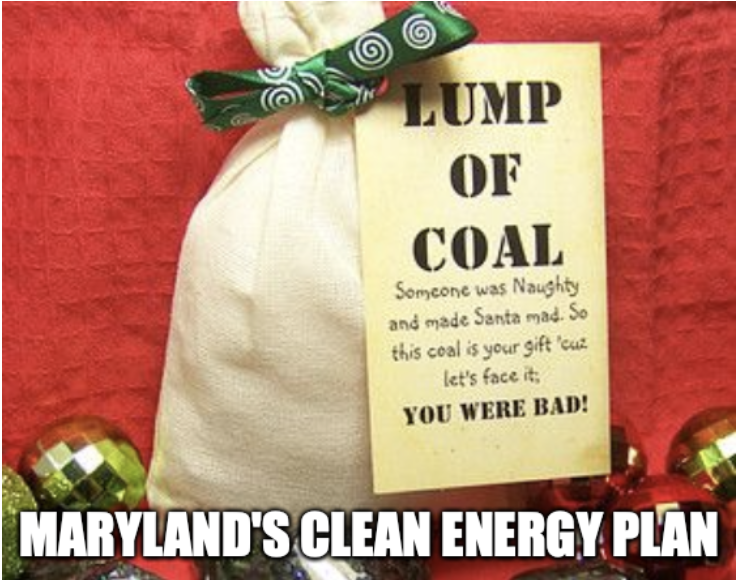But does that eliminate Maryland’s reliance on coal to keep the lights on? No, it doesn’t. Maryland already imports more than 40% of the energy is uses from surrounding states. Maryland’s plan calls for significant new imports after all coal-fired generation in the state retires.
Imported electricity from surrounding PJM states makes up over half of the electricity demand in Maryland in 2031 and contributes to over 95% of the remaining emissions in the power sector. In this pathway, although Maryland achieves its renewable and clean energy targets for in-state generation, the rapid expansion of solar and wind from current levels in this scenario is not sufficient to meet the growth in electricity demand from end-use sectors and to make up for reductions in natural gas generation. This means that Maryland must also increase imports from other states.”
Maryland has historically dealt with its failure to build enough of the clean energy it loves by filing lawsuits to force the shut down of dirty generation in other states.
“The petition asks the EPA to issue a finding that 36 electric generating units located in Indiana, Kentucky, Ohio, Pennsylvania, and West Virginia are in violation of the prohibition of 42 U.S.C. § 7410(a)(2)(D)(i), commonly referred to as the “good neighbor provision.” The petition alleges that nitrogen oxides emitted by these units significantly contribute to Maryland’s nonattainment, or interfere with its maintenance of certain National Ambient Air Quality Standards (“NAAQS”)”.
The generators are shutting down because of a settlement between Sierra Club and Talen Energy that was the result of a lawsuit. Neither Maryland, nor regional grid operator PJM Interconnection was party to the lawsuit. They just got left picking up the pieces to make sure the lights stay on. Maryland seems to be doing nothing except hoping for more solar, storage and offshore wind to offset a portion of Maryland’s energy deficiency. This is not realistic. Offshore wind has taken a beating recently. Maryland’s big project has recently been paused and is in danger of being cancelled.
But Maryland chooses to bury its head in the sand and push its responsibility to keep the lights on to regional grid planner PJM Interconnection. It’s up to PJM to keep the lights on despite Maryland’s electric suicide plans. PJM employs the only tool it has... new transmission to Maryland from surrounding states with excess fossil fuel generation. PJM seems quite pissed about it too, judging from its recent letter defending against Maryland’s attacks on who will pay for the new transmission.
And then you’ve got Sierra Club, jumping in to shift the blame and telling Maryland what PJM ought to do about the situation Sierra Club has created with its lawsuit against coal-fired generators. Sierra Club thinks PJM should just sit back and indulge in the fantasy that the lights will stay on because Sierra Club thinks they should. Sierra Club doesn’t have a realistic plan, but it doesn’t want to take any blame for what it has done.
Who is running the state of Maryland? Elected representatives or Sierra Club? Meanwhile, electric rates will skyrocket and Maryland will be using more coal-fired electricity than ever. This isn’t an energy transition and it’s not helping the environment. In fact, Maryland seems to be going backwards, put pretending that is is “clean”.
Maryland, just like Virginia, is nothing more than a filthy parasite. But the parasitic “clean energy” policies of Maryland and Virginia aren’t just hurting Maryland and Virginia. The misery caused by their incoherent energy strategies is spreading to other states. West Virginia will mine more coal, burn more coal, and transmit more coal-fired electricity to Maryland and Virginia via new high-voltage electric transmission lines. New transmission lines take property from residents of other states using eminent domain in order to make way for the new lines. And that’s just the physical impacts, residents of other states will also have to pay for the new transmission because Maryland and Virginia’s parasitic energy policies threaten reliability of the entire PJM grid, stretching as far west as Chicago, and as far south as Tennessee.
We cannot continue on this way and package this disaster as a beneficial transition. When the rubber meets the road, state clean energy policies are destroying electric reliability and affordable electricity for everyone.

 RSS Feed
RSS Feed